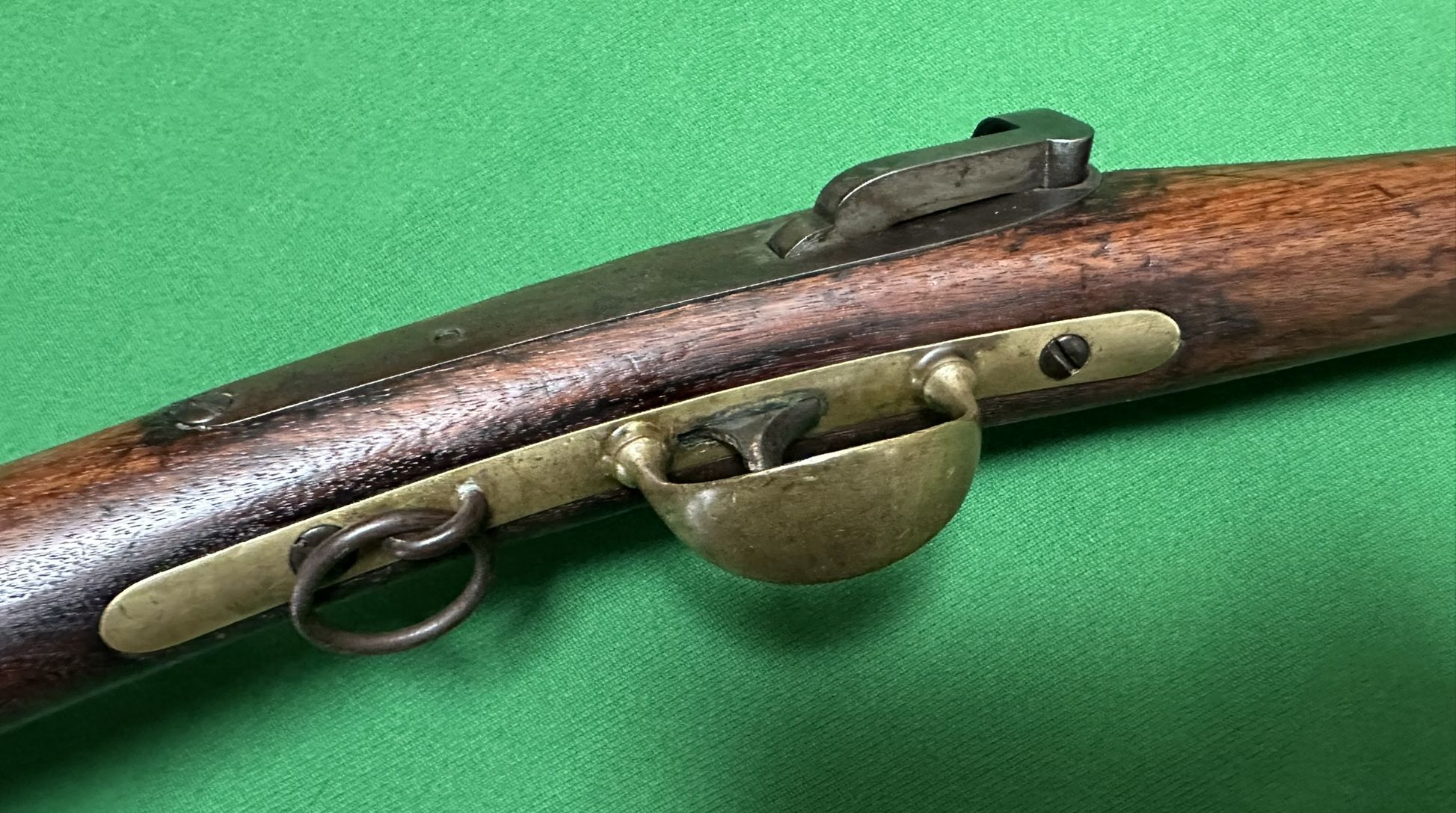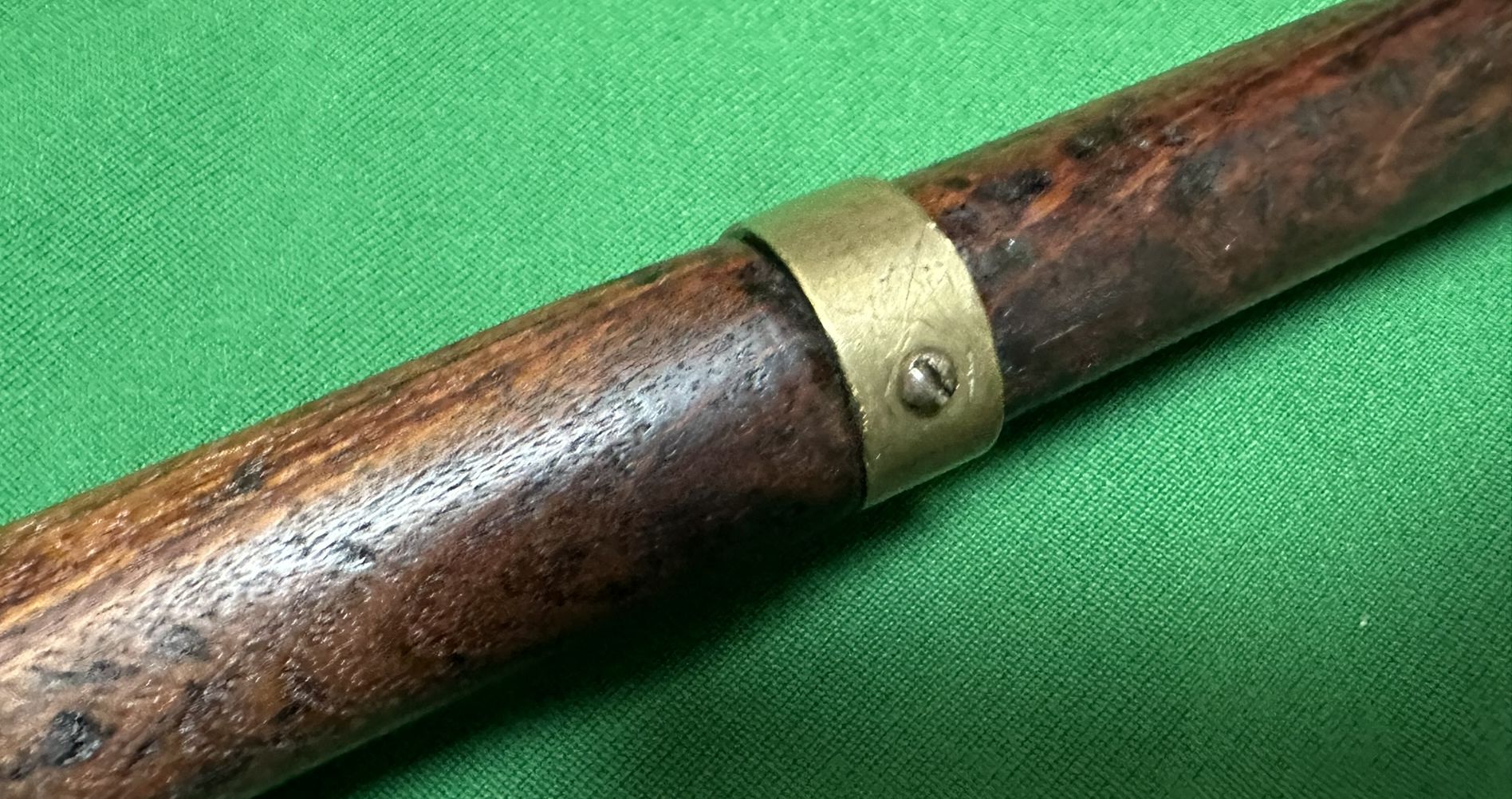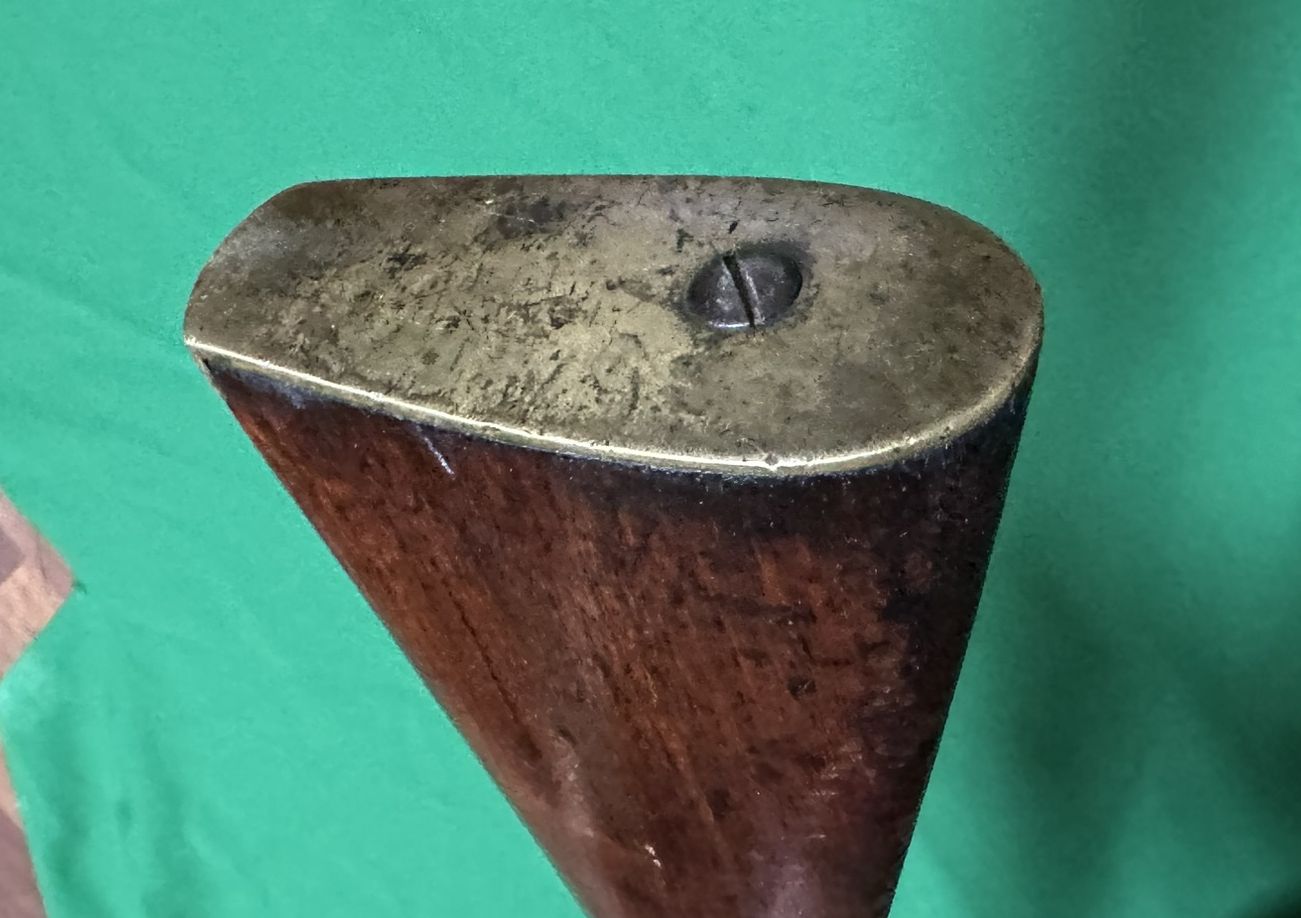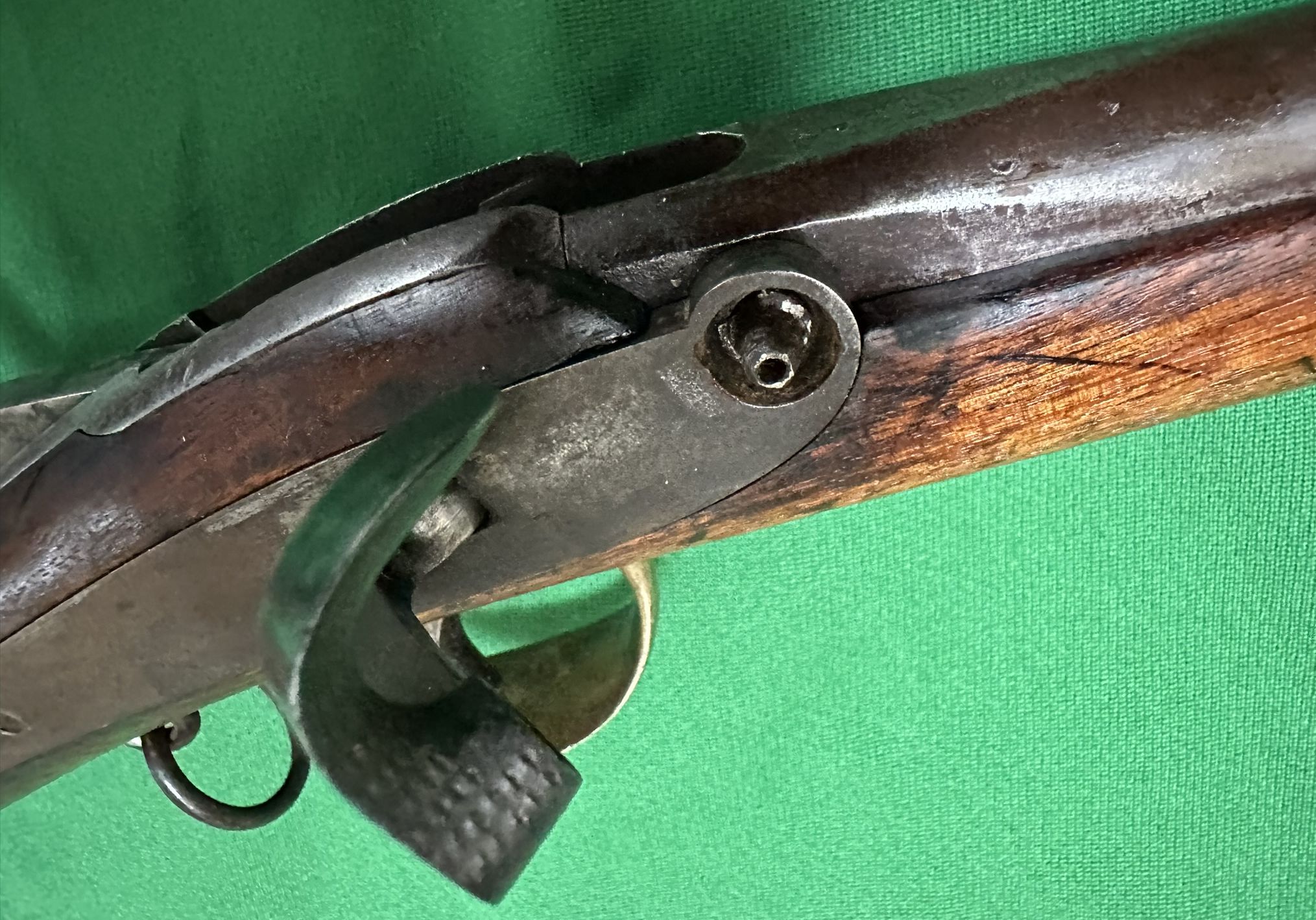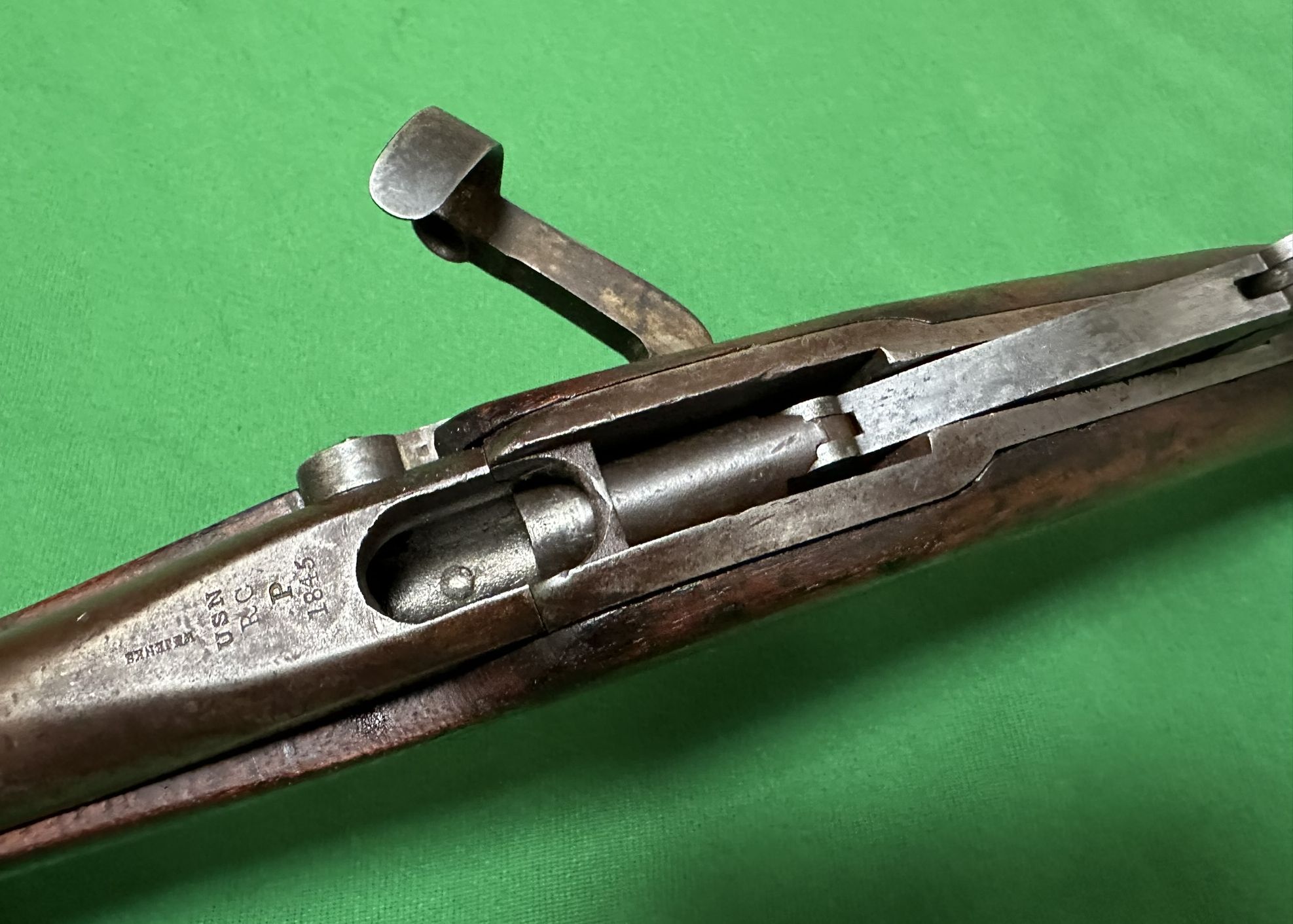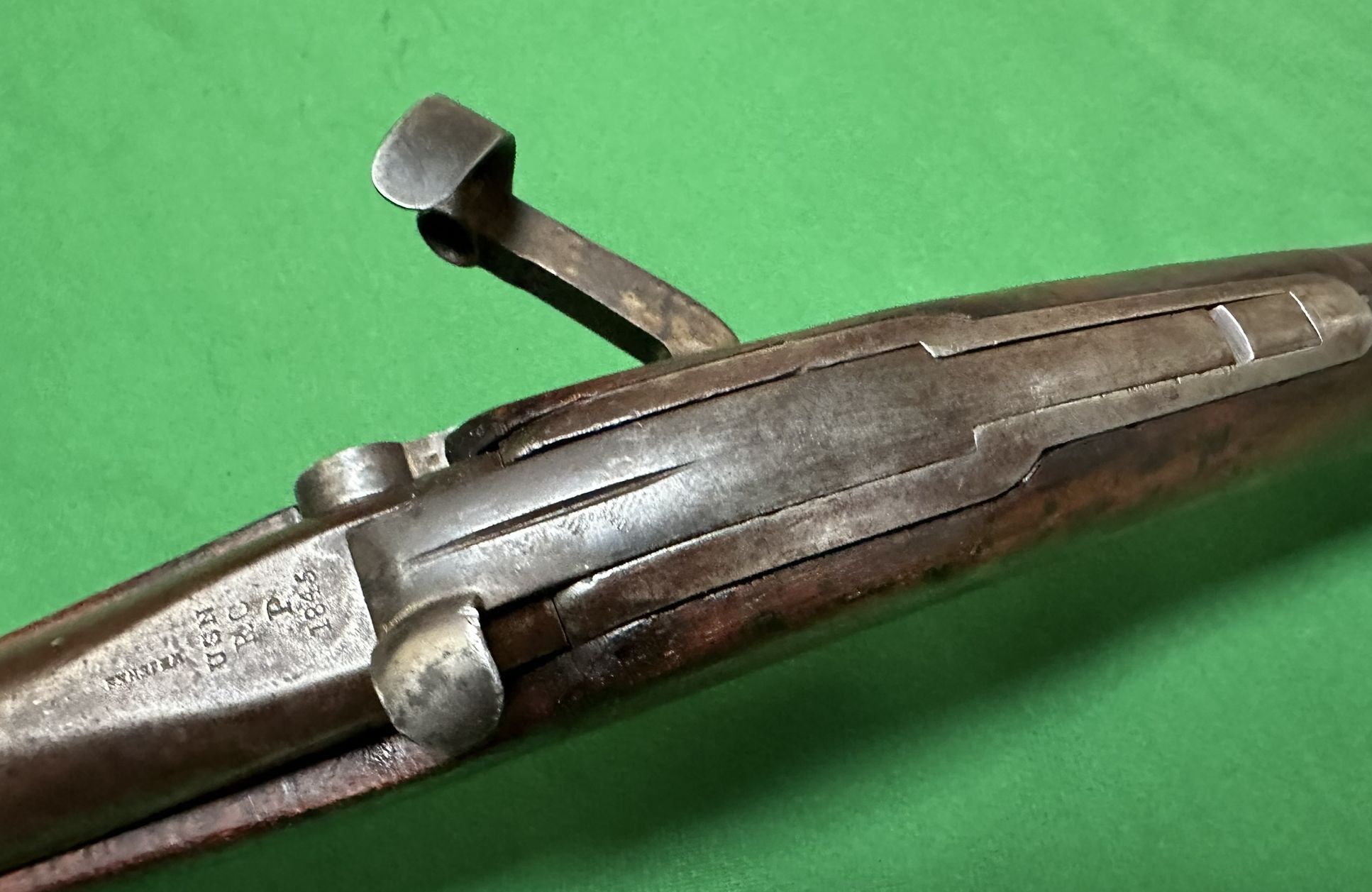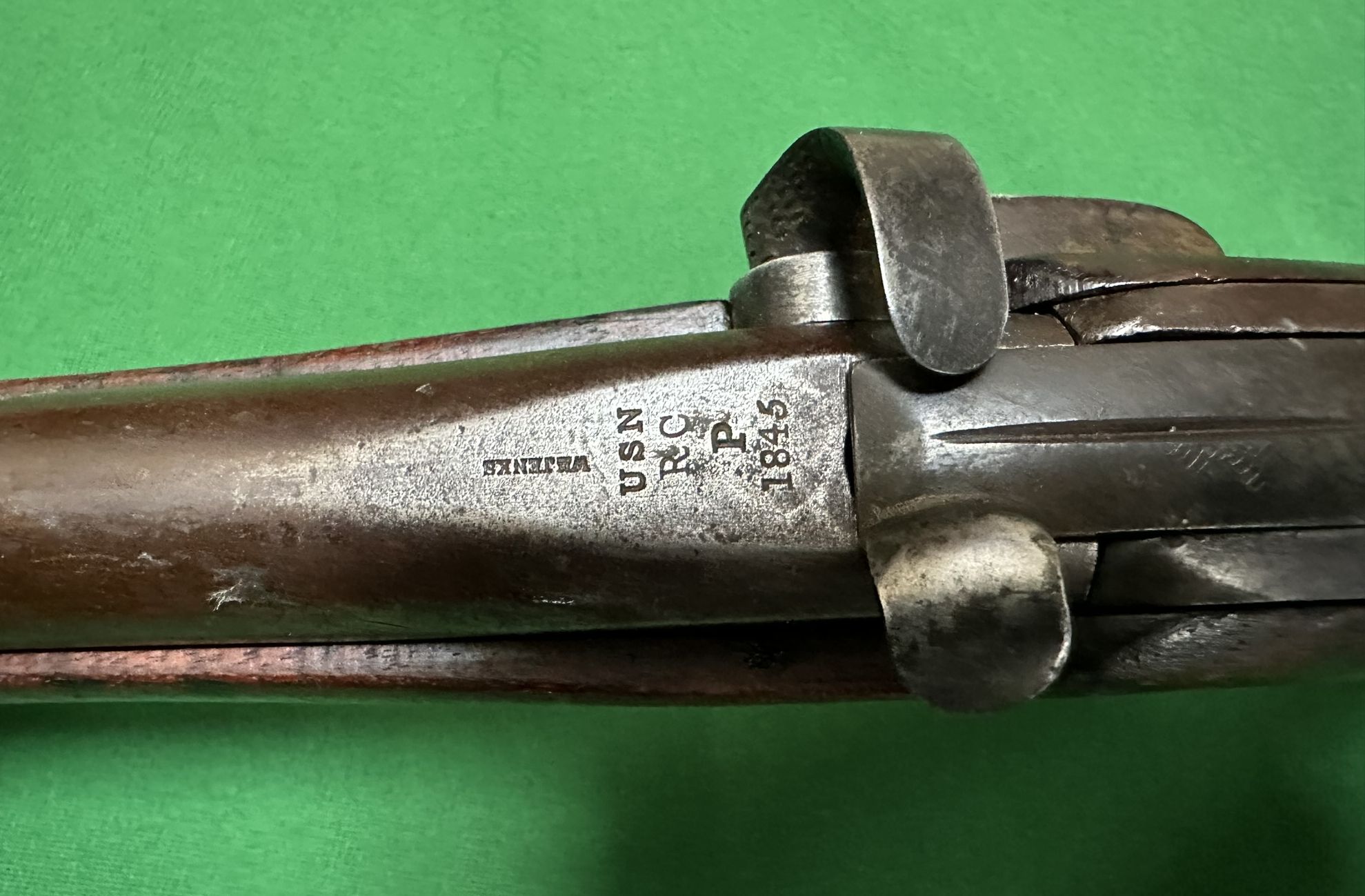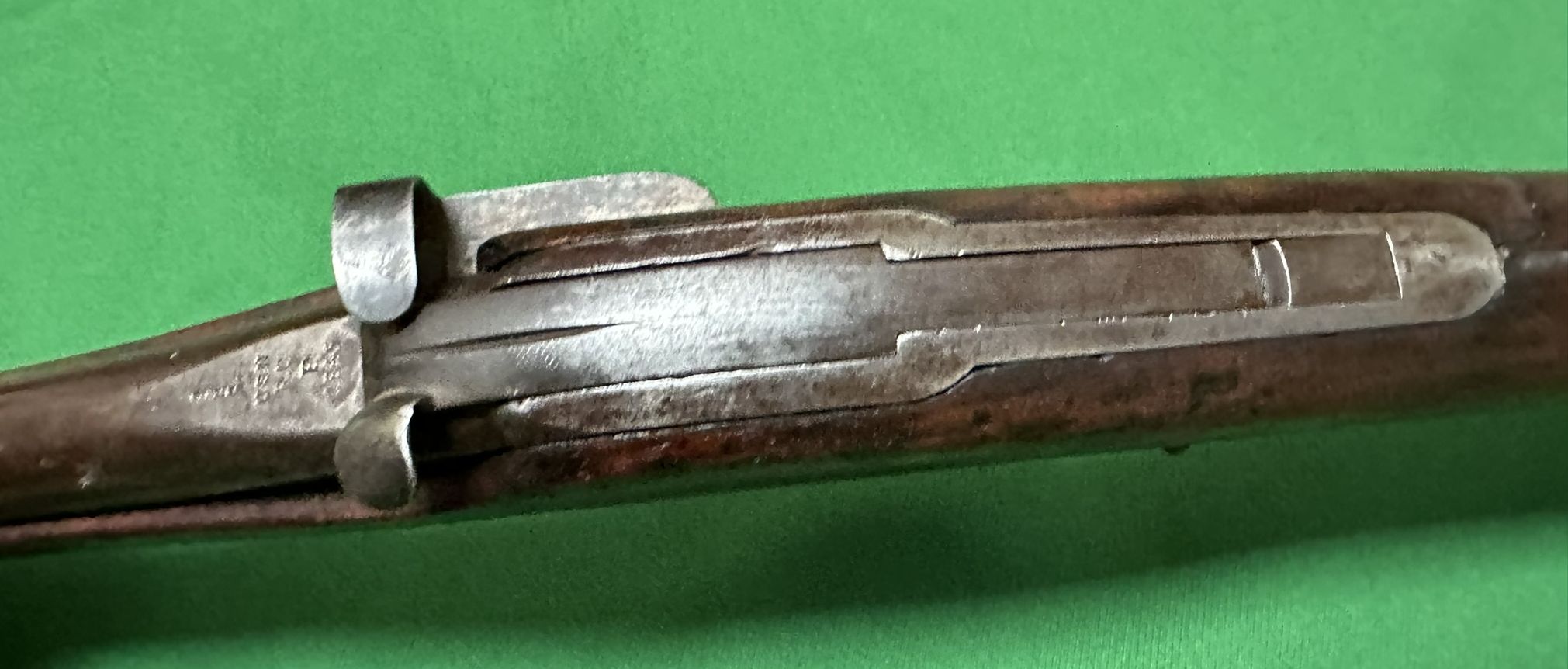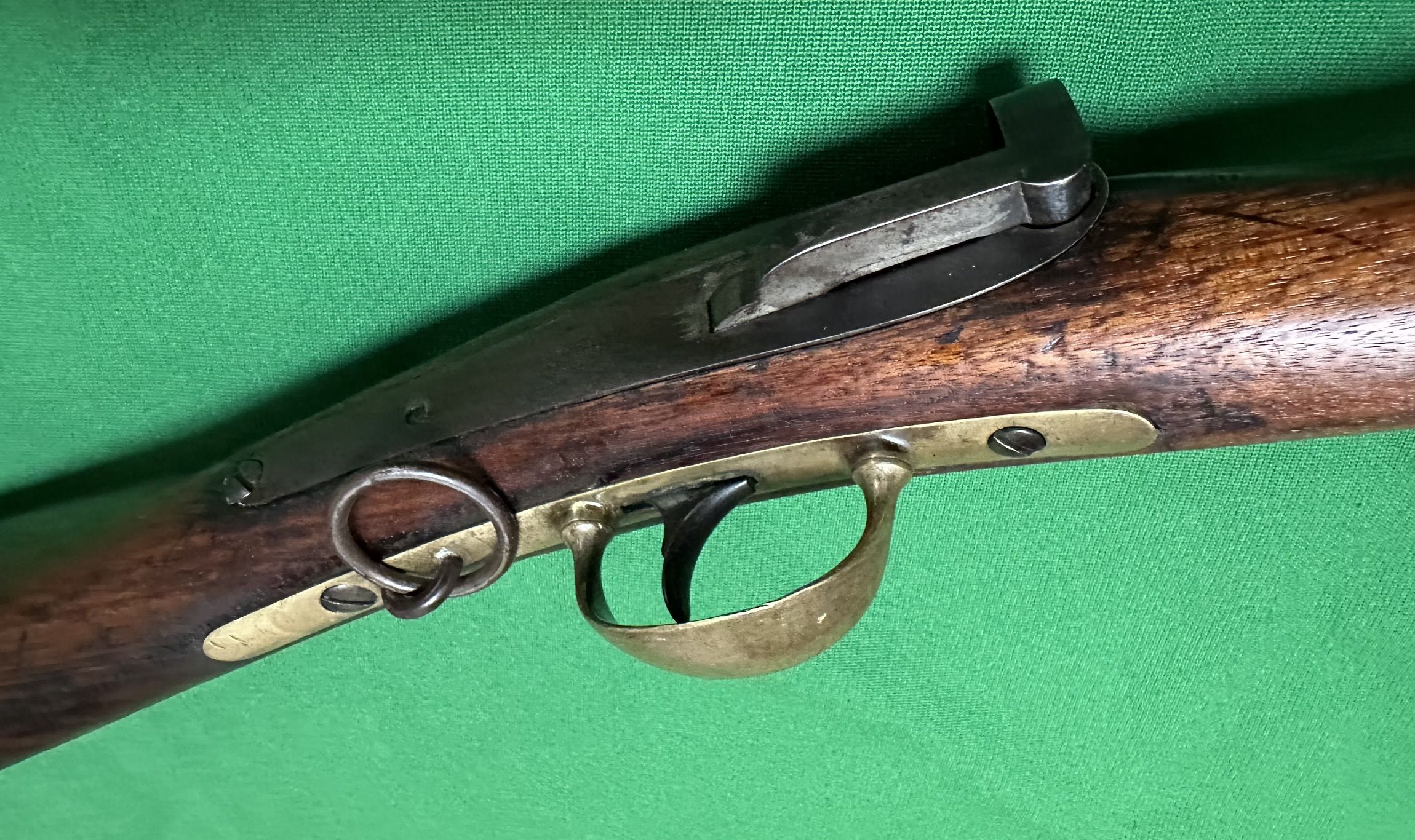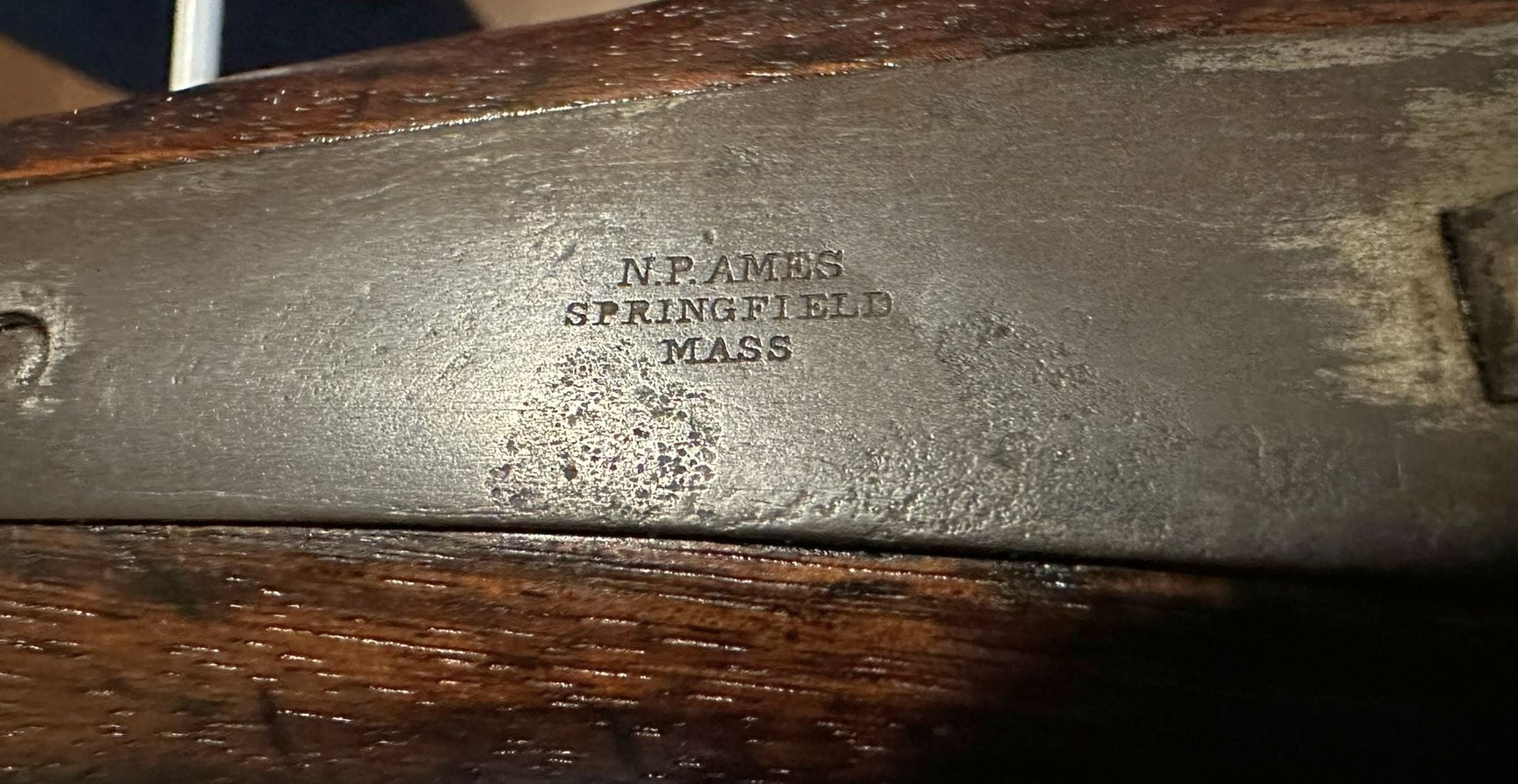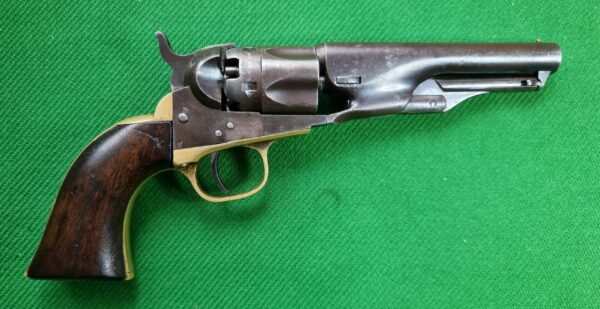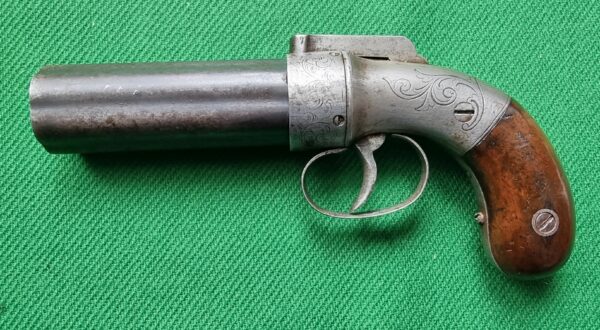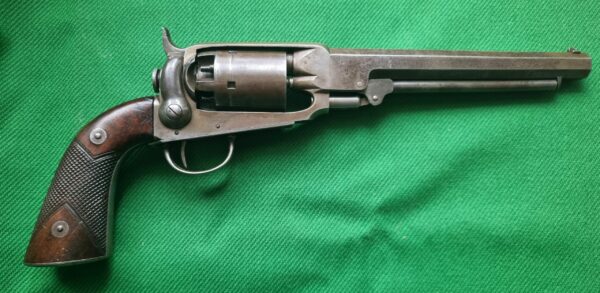Jenks Mule Ear carbine
Description
Jenks carbine rates about Factory New for the condition and color of the metal. The barrel is smooth with better than 95 percent blue shading to plum. The breech has strong color as well, as do the loading assembly, lockplate, hammer, and trigger, which show bright case color. The screw heads all show varying degrees of blue. The brass mounts all have smooth surfaces and pleasing, warm mustard color. Only the buttplate shows some age spotting. It has an excellent bore and mechanics.
The markings are sharp throughout. The breech is crisply stamped “W. JENKS” in line with the barrel and “USN / R.C. / P / 1846” perpendicularly just aft of that. The lockplate is crisply marked: “W. JENKS” at the rear and “N.P. AMES / SPRINGFIELD / MASS” forward. The loading lever is serial numbered 2638. The wood has good color, nice grain, but does show handling marks and some small dings overall, and a light set of initials “MW” on the right butt flat. It does, however, have a legible script inspector’s cartouche on the left wrist and a tight fit to the metal.
These sleek .54 caliber carbines were invented by William Jenks of South Carolina, who moved north after filing his patent to be closer to potential manufacturers and as the lock markings make clear struck a deal with the Ames brothers. His first contract for 100 flintlock carbines in 1839 was not a great success, but the Navy liked his design and its percussion configuration became the standard navy breechloader of the early-to-mid 1850s. The Navy signed its first contract for percussion versions in 1841, encompassing one thousand rifles and 500 carbines. The rifles were delivered between December 1843 and December 1844. The initial carbines were delivered starting in May 1843 and proved more popular, with three more contracts coming Jenks’s way from 1842 to 1844 (and delivered through 1846) for a total of 4200 carbines. The army only ordered another 44, but the Navy went so far as to issue a fourth contract in 1845 for 1,000 more, fitted with the Maynard tape primer. Judging from McAulay’s tables of contracts and purchases, this one was likely among 300 delivered the Boston Navy Yard in November 1845.
Jenks’s system used a side-hammer with vertical thumbpiece (hence the “mule-ear” nickname,) but his innovation was the use of a sliding breech bolt for loading. Raising and drawing back a lever at the wrist disclosed a loading aperture and drew back a plunger to admit the ball and powder. By 1861 other arms had largely replaced it for Navy use and A.M Eastman (of “Hall Carbine Affair” fame) purchased somewhere between 2800 and 3,143 from the Navy, and had them rifled and loading aperture altered to an oval shape to take a fixed cartridge, as this one shows, eventually placing them on the private market.
This is a very nice example of key weapon in the history of U.S. breechloading arms.
This is nice example of a scarce Jenks US Naval Carbine. Between 1843 and 1846 the NP Ames Company of Springfield, MA produced 4,250 of the standard Jenks breechloading percussion carbines for the US Navy. In 1847, an additional 1,000 “improved” Jenks carbines were ordered from E. Remington & Sons of Herkimer, NY, which included the automatic Maynard Patent Tape Priming system. These additional carbines were delivered in 1847 and 1848. The Remington assembled guns were manufactured on the original Ames machinery by Remington, who had purchased the contract for the 1,000 arms, as well as the machinery and all Jenks parts on hand (both finished and unfinished) from Ames. All of the Jenks carbines were originally manufactured as .54 caliber smoothbore guns, with a round loading aperture in the breech. Both versions of the carbine had 24.5” barrels secured by two screw-retained brass barrel bands, walnut stocks and brass furniture. With the coming of the Civil War, nearly all of the carbines were subsequently altered. The round loading aperture which was designed for loose powder and a round ball was enlarged to an oval opening which allowed the loading of paper cartridges. The majority of the carbines were also rifled during the alteration process. Today, it is very difficult to find a smoothbore Jenks carbine and nearly impossible to find an original configuration smoothbore Jenks with the round loading hole. The Jenks carbines manufactured by Remington with the Maynard Tape Primer represented only 19% of all Jenks carbine production for the Navy, and as such are very rare. The Navy preferred this “improved” version of the Jenks carbines and made a concerted effort to issue the tape primer equipped carbines to their small fleet of newly built screw frigates. The carbines were issued for service on the US Navy frigates USS Colorado, USS Merrimack, USS Minnesota, USS Niagara and the USS Wabash. All of these ships were outfitted between 1856 and 1858. According to author and researcher John McAulay, each frigate typically received 70 of the Remington made Jenks carbines. Remington Jenks carbines were also issued to the crews of the USS Congress, USS Cumberland, USS Susquehanna, USS Portsmouth and USS Saranac during the late 1850s. In December of 1858, it was reported that the Navy had 1,359 of 5,400 total Jenks carbines in service, with the belief that the large majority of these guns were of the tape primer variant, since the Navy showed a strong preference for the issue of that particular small arm.
With the beginning of the Civil War in 1861 the majority of the Jenks carbines were altered by rifling. Arthur Eastman & Simon Stevens contracted to alter 2,800 of the Jenks carbines by rifling their barrels. It is believed that they also enlarged the charging hole to the oval shape on any carbine that had not already had that alteration preformed. Clearly other contractors rifled these carbines as well, as the extant number of smoothbore carbines is quite small, indicating that only a very few of the guns escaped this modification. As the majority of the Jenks carbines owned by the Navy were in storage at the various Naval Yards when the war began, it can be reasonably assumed that those carbines which escaped alteration were those on station at remote points of the globe during the time frame that the modifications were performed. While the Navy placed more emphasis on the conventional muzzle loading rifled arms that were preferred by the Army during the Civil War, the Jenks carbine continued to be issued and to see significant use throughout the entire conflict. As a result, finding a high condition, tape primer equipped Jenks carbines can be very difficult.

